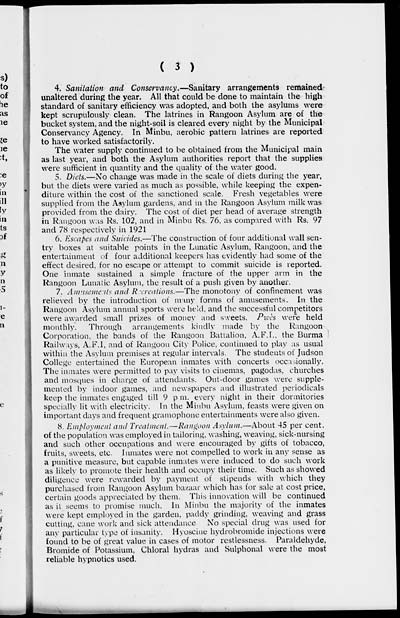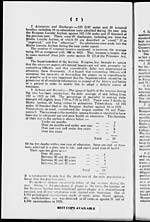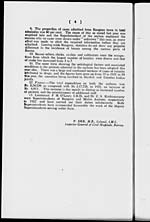Medicine - Mental health > 1907-1924 - Note on the lunatic asylums in Burma > 1922-1924 - Lunatic asylums Burma 1922-24 > Note on the lunatic asylums in Burma for the year 1922
(13) Page 3
Download files
Individual page:
Thumbnail gallery: Grid view | List view

( 3 )
4. Sanitation and Conservancy.—Sanitary arrangements remained
unaltered during the year. All that could be done to maintain the high
standard of sanitary efficiency was adopted, and both the asylums were
kept scrupulously clean. The latrines in Rangoon Asylum are of the
bucket system, and the night-soil is cleared every night by the Municipal
Conservancy Agency. In Minbu, aerobic pattern latrines are reported
to have worked satisfactorily.
The water supply continued to be obtained from the Municipal main
as last year, and both the Asylum authorities report that the supplies
were sufficient in quantity and the quality of the water good.
5. Diets.—No change was made in the scale of diets during the year,
but the diets were varied as much as possible, while keeping the expen-
diture within the cost of the sanctioned scale. Fresh vegetables were
supplied from the Asylum gardens, and in the Rangoon Asylum milk was
provided from the dairy. The cost of diet per head of average strength
in Rangoon was Rs. 102, and in Minbu Rs. 76, as compared with Rs. 97
and 78 respectively in 1921
6. Escapes and Suicides.—The construction of four additional wall sen-
try boxes at suitable points in the Lunatic Asylum, Rangoon, and the
entertainment of four additional keepers has evidently had some of the
effect desired, for no escape or attempt to commit suicide is reported.
One inmate sustained a simple fracture of the upper arm in the
Rangoon Lunatic Asylum, the result of a push given by another.
7. Amusements and Recreations.—The monotony of confinement was
relieved by the introduction of many forms of amusements. In the
Rangoon Asylum annual sports were held, and the successful competitors
were awarded small prizes of money and sweets. Pwès were held
monthly. Through arrangements kindly made by the Rangoon
Corporation, the bands of the Rangoon Battalion, A.F.I., the Burma
Railways, A.F.I, and of Rangoon City Police, continued to play as usual
within the Asylum premises at regular intervals. The students of Judson
College entertained the European inmates with concerts occasionally.
The inmates were permitted to pay visits to cinemas, pagodas, churches
and mosques in charge of attendants. Out-door games were supple-
mented by indoor games, and newspapers and illustrated periodicals
keep the inmates engaged till 9 p.m. every night in their dormitories
specially lit with electricity. In the Minbu Asylum, feasts were given on
important days and frequent gramophone entertainments were also given.
8. Employment and Treatment.—Rangoon Asylum.—About 45 per cent.
of the population was employed in tailoring, washing, weaving, sick-nursing
and such other occupations and were encouraged by gifts of tobacco,
fruits, sweets, etc. Inmates were not compelled to work in any sense as
a punitive measure, but capable inmates were induced to do such work
as likely to promote their health and occupy their time. Such as showed
diligence were rewarded by payment of stipends with which they
purchased from Rangoon Asylum bazaar which has for sale at cost price,
certain goods appreciated by them. This innovation will be continued
as it seems to promise much. In Minbu the majority of the inmates
were kept employed in the garden, paddy grinding, weaving and grass
cutting, cane work and sick attendance No special drug was used for
any particular type of insanity. Hyoscine hydrobromide injections were
found to be of great value in cases of motor restlessness. Paraldehyde,
Bromide of Potassium, Chloral hydras and Sulphonal were the most
reliable hypnotics used.
Set display mode to: Large image | Zoom image | Transcription
Images and transcriptions on this page, including medium image downloads, may be used under the Creative Commons Attribution 4.0 International Licence unless otherwise stated. ![]()
| India Papers > Medicine - Mental health > Note on the lunatic asylums in Burma > Lunatic asylums Burma 1922-24 > Note on the lunatic asylums in Burma for the year 1922 > (13) Page 3 |
|---|
| Permanent URL | https://digital.nls.uk/83981395 |
|---|
| Description | Reports cover 1922-1924. |
|---|




